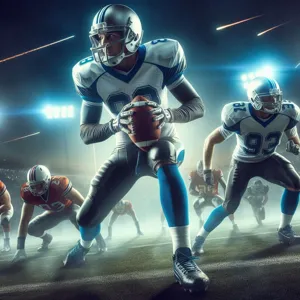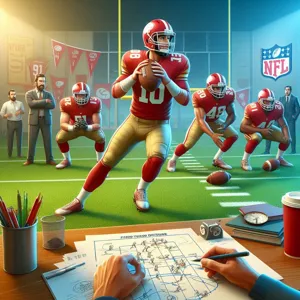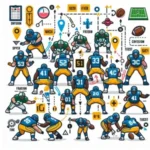In the high-octane world of American football, a strong pass defense can be the difference between victory and defeat.
As teams strategize to outmaneuver their opponents, the ability to effectively defend against aerial attacks becomes paramount. Whether you’re a seasoned coach looking to refine your defensive tactics or a player eager to elevate your game on the field, understanding the nuances of pass defense is essential. In this blog post, we will explore seven powerful strategies designed to bolster your team’s defensive prowess, from mastering zone coverage techniques to enhancing communication among players. With these actionable insights, you’ll equip your team with the tools needed to shut down opposing quarterbacks, create turnovers, and ultimately, dominate the gridiron. Get ready to transform your pass defense and elevate your team’s performance to new heights!
1. Understanding the Importance of Pass Defense

In American football, the pass defense is not merely a segment of the game; it is a cornerstone of a team’s overall strategy and success. Understanding its importance is crucial for coaches and players alike. At its core, pass defense is about thwarting the opponent’s aerial attacks, preventing them from advancing down the field, and ultimately, scoring points. But its significance goes far beyond just stopping the ball from being thrown successfully.
A strong pass defense can set the tone for the entire game, instilling confidence in your team while demoralizing your opponents. When defensive backs and linebackers execute their roles effectively, they not only disrupt passes but also create opportunities for turnovers, such as interceptions and fumbles. These game-changing moments can swing momentum dramatically, leading to crucial points for your team and putting pressure on the opposing offense.
Moreover, a solid pass defense can alter an opponent’s game plan. When a team knows they face a formidable pass defense, they may shy away from their intended offensive strategies, resulting in conservative play-calling. This can lead to an overall decrease in their offensive productivity, giving your team a strategic advantage.
Additionally, pass defense is vital for building teamwork and communication among players. Defensive backs must work in sync with linebackers and the defensive line, coordinating their movements and anticipating the quarterback’s decisions. This collaborative effort fosters a sense of unity and trust, strengthening the team’s overall performance.
In summary, understanding the importance of pass defense is foundational in American football. It serves as a formidable barrier against scoring, shapes the dynamics of the game, and promotes team cohesion, making it essential for any successful team strategy. As we explore the strategies to enhance your team’s pass defense further, keep in mind that this is not just a defensive mechanism—it’s a proactive approach to winning games.
2. Analyzing Opponent’s Passing Strategies
Understanding your opponent’s passing strategies is pivotal in fortifying your team’s pass defense. This analysis goes beyond mere statistics; it delves into the very fabric of the opposing team’s offensive game plan. By dissecting their tendencies, formations, and key players, you can tailor your defensive strategies to exploit their weaknesses and mitigate their strengths.
Start by reviewing game film to identify the quarterback’s habits. Does he favor quick releases, or does he hold onto the ball, waiting for deeper routes to develop? Pay attention to his favorite targets and the routes they typically run. For instance, if a receiver consistently excels on slant routes, you might want to instruct your defensive backs to play tighter coverage in that area, anticipating the throw.
Additionally, consider the offensive line’s performance. A strong line can give a quarterback the time he needs to survey the field and make accurate throws. Conversely, a line that struggles with protection can lead to hurried passes and mistakes. By analyzing past games, you can identify blitz opportunities that might rattle the quarterback, making him more susceptible to errant throws.
Moreover, be vigilant about the specific situations in which the opponent tends to pass—short yardage, third downs, or in the red zone. Each scenario may prompt a different approach, allowing you to devise situational strategies that anticipate their moves. Understanding these nuances not only enhances your team’s ability to defend against their passing game but also builds confidence in your players, knowing they are prepared for what they might face on game day.
Incorporating this analysis into your practice sessions can further solidify your game plan. Run drills that mirror the opponent’s passing strategies, allowing your defensive players to familiarize themselves with their routes and timing. This hands-on approach will help your team develop quick reactions and improve communication on the field, ultimately leading to a more cohesive and effective pass defense when the game is on the line.
3. Implementing Effective Coverage Schemes

Implementing effective coverage schemes is a vital strategy for strengthening your team’s pass defense in American football. A well-structured coverage scheme not only confuses the opposing quarterback but also enhances the synergy among your defensive players, creating a more formidable wall against aerial attacks.
To begin with, you need to assess the strengths and weaknesses of your defensive personnel. Are your cornerbacks quick and agile, or are they more physical and adept at press coverage? Knowing your players’ capabilities will help you tailor your coverage schemes to maximize their effectiveness. For instance, if you have speedy cornerbacks, consider utilizing a man-to-man coverage scheme that allows them to stick closely to their assigned receivers, capitalizing on their quickness to limit separation.
Additionally, incorporating zone coverage can be particularly beneficial, especially against teams that rely heavily on short, quick passes. In zone coverage, defenders are assigned specific areas of the field rather than individual receivers, allowing them to anticipate routes and react quickly to the quarterback’s movements. This not only complicates the quarterback’s read but also creates opportunities for interceptions and deflected passes, as defenders can converge on the ball more effectively.
Moreover, mixing up your coverage schemes throughout the game can keep the opposing offense guessing. By transitioning between man and zone coverage, or even employing hybrid schemes, you can disrupt the rhythm of the opposing team’s passing game. This unpredictability forces quarterbacks into making split-second decisions, often leading to mistakes.
Communication is also key in executing effective coverage schemes. Ensure that your players are well-versed in their responsibilities and can quickly adapt to changing situations on the field. Regular drills focused on communication can help reinforce this aspect, making it second nature during high-pressure game scenarios.
Finally, film study is an indispensable tool for improving your coverage schemes. Analyzing game footage helps identify patterns in the opposing offense, enabling your team to anticipate routes and recognize tendencies. By understanding how the opposition operates, you can adjust your coverage schemes accordingly, giving your defense a strategic edge.
Incorporating these elements into your pass defense strategy will not only strengthen your coverage but also foster a more cohesive and confident defensive unit, ready to take on any challenge that comes their way.
4. Developing Strong Communication Among Players
In the fast-paced world of American football, where split-second decisions can determine the outcome of a game, strong communication among players is paramount—especially in pass defense. Defensive backs must work in concert, anticipating their teammates’ movements and intentions while remaining vigilant to the offense’s strategies. Without effective communication, even the most skilled athletes can find themselves out of position, leading to big plays for the opposing team.
To develop this crucial aspect of gameplay, teams should foster an environment where open dialogue is encouraged both on and off the field. During practice, players should be prompted to vocalize their reads and reactions, ensuring that everyone is on the same page. For instance, if a cornerback notices a particular route running pattern from a wide receiver, they should communicate this immediately to the safety, allowing for adjustments in coverage. Implementing signals or coded language can also enhance understanding during high-pressure situations, reducing confusion amidst the chaos of the game.
Furthermore, regular team meetings can reinforce this communication culture. Reviewing game film together allows players to point out key moments where communication either succeeded or failed, solidifying the lessons learned. Additionally, integrating fun team-building exercises that focus on communication skills can enhance camaraderie and trust, making players more likely to rely on each other during critical moments on the field.
Ultimately, developing strong communication among players not only improves pass defense effectiveness but also builds a cohesive unit that thrives on collaboration. A well-communicating defense is a formidable force, capable of adapting and reacting dynamically to the ever-evolving landscape of the game.
5. Enhancing Defensive Line Techniques

Enhancing the techniques of your defensive line is crucial for a robust pass defense in American football. The defensive line acts as the first line of defense against the opposing quarterback, and their effectiveness can significantly impact the outcome of a game. Here are some targeted strategies to elevate their performance on the field.
Firstly, focus on improving their stance and initial burst off the line. A low, balanced stance allows for quicker reactions and explosive speed, enabling linemen to engage blockers more effectively. Incorporate drills that emphasize quick starts and agility, helping players to get an edge in the race to the quarterback.
Next, teach your defensive linemen the art of hand placement and disengagement techniques. Successful pass rushers use their hands not just to engage blockers but also to shed them and make their way to the quarterback. Drills that focus on hand fighting, such as “rip” and “swim” moves, can enhance their ability to navigate through opposing linemen and increase their sack potential.
In addition to physical techniques, instilling a strong understanding of game mechanics is essential. Encourage players to study the opposing quarterback’s tendencies and the offensive line’s blocking schemes. This knowledge can help them anticipate plays, allowing them to adjust their techniques accordingly. Consider implementing film study sessions to analyze both their own performance and that of their opponents, reinforcing the connection between technique and game awareness.
Moreover, emphasize the importance of teamwork among the defensive line. Each player should be aware of their role within the defensive scheme, especially during stunts and twists designed to confuse the offensive line. Conducting coordinated drills that simulate game-like scenarios will help linemen develop chemistry and communication, which is vital for executing complex defensive strategies.
Lastly, conditioning cannot be overlooked. A well-conditioned defensive line will maintain their intensity throughout the game, enabling them to consistently pressure the quarterback and defend against the pass. Incorporate sport-specific conditioning drills that mimic game situations, ensuring that your players remain agile, explosive, and capable of sustaining their performance in the later stages of the match.
By enhancing defensive line techniques through focused training, strategic understanding, and teamwork, you can significantly bolster your team’s pass defense and become a formidable presence on the field.
6. Leveraging Linebackers in Pass Defense
Linebackers play a critical role in pass defense, acting as a bridge between the defensive line and the secondary. Leveraging their skills effectively can transform a team’s ability to thwart aerial attacks. These versatile athletes possess a unique combination of speed, agility, and football IQ, making them essential in both run support and pass coverage.
When it comes to defending against the pass, deploying linebackers strategically can create mismatches and disrupt the quarterback’s rhythm. One effective strategy is to utilize them in zone coverage schemes, where they can drop back into the passing lanes. This allows them to read the quarterback’s eyes, anticipate throws, and jump routes, increasing the likelihood of interceptions or deflections.
Additionally, linebackers can be employed as blitzers, applying pressure on the quarterback to force hurried throws. This dual-threat capability keeps offenses guessing and can often lead to mistakes, especially if the quarterback is forced to make quick decisions under duress. It’s essential, however, to have a solid understanding of when to send them on a blitz versus when to keep them in coverage, as a well-timed blitz can catch an offense off guard, while overcommitting can leave dangerous gaps in the defense.
Training linebackers to recognize offensive formations and adjust their responsibilities accordingly is also crucial. By instilling this awareness, they can better anticipate plays and react swiftly, turning potential completions into tackles for loss. Practicing scenarios that force linebackers to make quick decisions during drills can sharpen their instincts and improve their overall effectiveness in pass defense.
Incorporating film study into your linebackers’ training regimen can further enhance their understanding of opponents’ tendencies. By analyzing past games, they can identify patterns in the opposing team’s passing game, enabling them to anticipate routes and make smarter plays on the field.
Ultimately, by maximizing the impact of your linebackers in pass defense, you’ll not only strengthen your team’s overall defensive strategy but also create a more formidable unit capable of shutting down even the most potent passing attacks.
7. Training Cornerbacks for Success

Training cornerbacks for success is a crucial component of building a resilient pass defense in American football. These athletes are often the first line of defense against opposing wide receivers, and their ability to closely match the speed and agility of these offensive players can make or break a game. To enhance their skills, it’s essential to implement a comprehensive training regimen that focuses on both physical conditioning and technical proficiency.
Start by emphasizing agility and footwork drills. Cornerbacks must possess the ability to pivot quickly and change direction on a dime to stay in stride with receivers. Ladder drills, cone drills, and shuttle runs can help sharpen their foot speed and coordination. These exercises not only improve their athleticism but also enhance their reaction times, allowing them to respond swiftly to the receiver’s movements.
In addition to physical training, instilling a strong understanding of defensive schemes is vital. Cornerbacks should be well-versed in various coverage techniques, such as man-to-man and zone coverage. Conducting film sessions can provide valuable insights into the strengths and weaknesses of opposing receivers, helping cornerbacks anticipate routes and positioning themselves effectively. Encourage players to study their opponents’ tendencies and develop a mental playbook that they can draw upon during games.
Moreover, incorporating simulated game situations into practice is key. Set up one-on-one drills that mimic real-game scenarios, allowing cornerbacks to practice their coverage skills against receivers. This will build their confidence and give them the opportunity to refine their techniques in a controlled environment. Coaches should provide constructive feedback during these drills, reinforcing the importance of timing, body positioning, and hand placement to disrupt the receiver’s route.
Finally, fostering a culture of camaraderie and communication among the defensive backs is essential. Cornerbacks need to work in tandem with safeties and linebackers, creating a cohesive unit that can effectively cover receivers and respond to offensive schemes. Encourage open dialogue on the field, where players can share observations and adjustments in real time.
By focusing on agility training, understanding defensive strategies, simulating game scenarios, and promoting teamwork, you can effectively train cornerbacks to excel in pass defense. With these strategies in place, your team’s secondary will be well-equipped to face any challenge that comes their way on the field.
8. Utilizing Safeties in Coverage and Support Roles
In the ever-evolving landscape of American football, the role of safeties has become crucial in fortifying a team’s pass defense. Traditionally viewed as the last line of defense, safeties are now expected to be versatile players who can excel in both coverage and support roles. By strategically utilizing safeties, teams can enhance their defensive schemes and create a more formidable barrier against opposing passing attacks.
First and foremost, it’s essential to understand the dual responsibilities of safeties. In coverage, they must possess the agility and awareness to track receivers, anticipate routes, and react quickly to the quarterback’s decisions. Coaches should emphasize developing their safeties’ skills in man-to-man coverage, as well as zone concepts, allowing them to effectively blanket receivers or read the quarterback’s eyes to jump routes. This adaptability is critical, especially when facing high-powered offenses that employ a variety of passing strategies.
Moreover, safeties play a vital support role, acting as a safety net for cornerbacks and linebackers. When a cornerback gets caught in a mismatch or when a linebacker must drop back to cover a tight end or running back, the safety can provide crucial help. Training safeties to recognize these situations and react accordingly can turn a potential big play into a minor gain. Coaches should implement drills that simulate these scenarios, helping safeties develop their instincts and decision-making abilities under pressure.
In addition to their on-field responsibilities, safeties should be encouraged to act as leaders in the secondary. Their ability to read the offense and communicate effectively with teammates can make a significant difference in defensive cohesion. By fostering an environment where safeties take charge of relaying calls and adjustments, teams can ensure that every player is on the same page, reducing the chances of breakdowns in coverage.
Lastly, consider integrating safeties into blitz packages. Their unique skill set allows them to be effective in both coverage and rushing the passer. When safeties can disrupt the backfield, it not only increases the pressure on the quarterback but also creates opportunities for turnovers through hurried throws or sacks. This dual-threat capability can keep opposing offenses guessing and elevate a team’s overall defensive performance.
By strategically utilizing safeties in coverage and support roles, teams can significantly strengthen their pass defense. With the right training, communication, and game planning, safeties can transform from mere defenders into dynamic playmakers who help secure victories on the gridiron.
9. Practicing Situational Awareness in Game Scenarios
Practicing situational awareness in game scenarios is crucial for developing a robust pass defense. In the fast-paced world of American football, players must be adept at reading the field, recognizing formations, and anticipating the opponent’s next move. This skill goes beyond mere physicality; it requires mental acuity and a strong grasp of game strategy.
To enhance situational awareness, consider incorporating scenario-based drills into your practice regimen. These drills should simulate realistic game conditions, allowing players to react to various offensive strategies, such as the hurry-up offense or a two-minute drill. For example, set up specific situations where the offense is in a third-and-long scenario. Challenge your defenders to communicate effectively, align properly, and make quick decisions based on the offensive formation.
Additionally, film study can significantly boost players’ understanding of situational awareness. Reviewing game footage helps players recognize patterns in the opponent’s passing game and understand the tendencies of key offensive players. Encourage your team to ask questions and discuss what they observe, fostering a culture of collective learning and awareness.
Finally, instill a mindset of adaptability. In the heat of the moment, the ability to adjust one’s approach based on the unfolding game scenario is what often separates good teams from great ones. Emphasize the importance of staying focused and composed, regardless of the situation, to ensure that your players are always one step ahead of the offense. By honing these skills, your team will be well-equipped to defend against the pass and respond effectively to any challenge they might face on the field.
10. Incorporating Film Study into Team Practices
Incorporating film study into team practices is a critical strategy for enhancing your team’s pass defense. Analyzing game footage allows players to gain invaluable insights into their own performance as well as that of their opponents. By reviewing previous games, coaching staff can identify patterns in quarterback behavior, receiver routes, and offensive line formations that may signal a play.
During practice sessions, allocate time for players to watch and discuss film together. This collaborative approach not only fosters a sense of unity among teammates but also encourages open dialogue about positioning, decision-making, and techniques. For instance, focusing on a particular game where the defense excelled can boost confidence, illustrating successful tactics that can be replicated. Conversely, examining moments when the defense struggled can pinpoint areas for improvement, allowing players to learn from their mistakes.
Make use of technology to enhance the film study experience. Utilize tablets or smart TVs to break down plays in real-time, allowing for immediate feedback and discussion. Slow-motion replays can help players understand the nuances of their movements, while highlighting specific plays can reinforce essential concepts. Encourage players to take notes and ask questions during film sessions, fostering a culture of continuous learning and improvement.
By embedding film study into regular practice routines, you empower your players to become more analytical and strategic thinkers on the field. This mental preparation complements physical drills, equipping your team with the knowledge necessary to anticipate and counteract the offensive strategies they’ll face in upcoming games. Ultimately, this holistic approach to training will help strengthen your team’s pass defense, leading to greater success on game day.
11. Fostering a Culture of Accountability and Trust
Fostering a culture of accountability and trust is essential for any football team aiming to enhance its pass defense. In a game where split-second decisions can determine the outcome, players must feel empowered to take responsibility for their actions on the field and trust their teammates to do the same. This begins with open communication—coaches should encourage players to express their thoughts, concerns, and observations without fear of judgment. When players know they can speak freely, it creates an environment where feedback is valued, and collective growth is prioritized.
Moreover, accountability can be cultivated through clearly defined roles and expectations. Each player should understand their specific responsibilities within the pass defense scheme, from the cornerbacks and safeties to the defensive linemen. Regular team meetings and film sessions can help reinforce these concepts, allowing players to analyze their performances and learn from mistakes. Celebrating individual and team successes fosters motivation, while addressing shortcomings in a constructive manner builds resilience.
Trust is built over time and is crucial during high-pressure situations. Teams that practice together consistently develop chemistry, which translates into better performance on game day. Encouraging camaraderie off the field through team-building activities can further strengthen these bonds. When players trust that their teammates will execute their roles effectively, they can play more instinctively, reacting quickly to the quarterback and receivers without hesitation.
In summary, cultivating a culture of accountability and trust creates a foundation for a robust pass defense. By prioritizing communication, clearly defining roles, and fostering strong relationships, teams can enhance their defensive cohesion and performance, ultimately leading to more successful outcomes on the field.
12. Monitoring Progress and Adjusting Strategies
Monitoring progress and adjusting strategies is a critical component of developing a formidable pass defense in American football. It’s not enough to simply implement a game plan and hope for the best; ongoing evaluation and adaptation are key to ensuring that your team can effectively counter opposing offenses throughout the season.
Start by establishing clear metrics for success. Whether it’s the number of completed passes allowed, yardage given up, or interceptions made, having specific goals in mind will help you gauge your team’s performance. Utilize game film analysis to review both your own defensive plays and those of your opponents. This allows you to identify patterns, strengths, and weaknesses that can inform your strategy.
During practices, incorporate drills that focus on the areas needing improvement. If your defensive backs are struggling with coverage, dedicate time to one-on-one drills that emphasize footwork and positioning. If communication is lacking on the field, implement scenarios that require players to call out assignments and adjustments before the snap.
Moreover, be prepared to adjust your strategies based on the evolving dynamics of your roster and the competition. Injuries, player development, and even the style of play of upcoming opponents can necessitate changes in your approach. Encourage open communication during team meetings, where players can voice their insights and observations. This not only fosters a collaborative team environment but also empowers players to take ownership of their roles within the defense.
Lastly, don’t forget to celebrate progress, no matter how small. Acknowledging improvements helps keep morale high and motivates players to stay focused on the shared goal of becoming a stronger pass defense unit. By consistently monitoring progress and being willing to adjust strategies, your team will not only enhance its pass defense but also develop the resilience needed to thrive in high-pressure situations on the field.
13. Engaging in Regular Conditioning and Agility Training
Engaging in regular conditioning and agility training is essential for enhancing your team’s pass defense. In American football, the ability to maintain peak physical performance throughout the game can be the difference between a successful defensive stand or allowing a pivotal completion. Conditioning goes beyond mere endurance; it encompasses strength, speed, and flexibility—all vital for players tasked with defending against the opposing offense’s aerial attack.
Incorporating drills that focus on footwork and lateral movements can significantly improve defensive backs’ ability to mirror receivers and react swiftly to their routes. For instance, agility ladders and cone drills can sharpen quick footwork, allowing defenders to change direction seamlessly while maintaining balance and speed. These drills not only cultivate physical agility but also enhance cognitive reflexes, preparing players to anticipate routes and make split-second decisions during gameplay.
Moreover, including high-intensity interval training (HIIT) in your conditioning regimen can help simulate game-like scenarios, pushing athletes to perform explosive movements followed by short recovery periods. This kind of training mimics the bursts of energy needed during a play and helps build the stamina necessary to sustain high-level performance throughout the game.
Regularly scheduled conditioning sessions should also emphasize the importance of teamwork. Incorporating group drills can foster camaraderie and improve communication among players, developing a cohesive unit that works seamlessly together during defensive plays. When players are physically prepared and attuned to each other’s movements, they can react more effectively to the offense’s strategies, ultimately leading to a more formidable pass defense.
In summary, prioritizing conditioning and agility training not only enhances individual performance but also strengthens the overall defensive unit. By committing to this aspect of training, your team will be better equipped to handle the challenges of the passing game, making them a tougher opponent on the field.
14. Building Team Chemistry Through Team-Building Activities
In the high-stakes world of American football, where split-second decisions can determine the outcome of a game, team chemistry is not just a bonus; it’s a necessity. Building strong relationships off the field can enhance communication and understanding during gameplay, particularly in pass defense, where coordinated efforts are crucial. Implementing team-building activities provides an excellent opportunity for players to bond, fostering trust and camaraderie that translate into improved performance on the field.
Consider organizing a mix of physical and social activities that help to break down barriers and promote collaboration. Outdoor challenges like obstacle courses or trust falls encourage players to rely on one another, strengthening their synergy. These activities can help defensive backs and linebackers develop a deeper understanding of each other’s playing styles and instincts, which is invaluable when anticipating offensive plays.
Moreover, social gatherings—such as team dinners, movie nights, or game days—allow players to engage with one another in a relaxed environment. This downtime helps build friendships beyond the competitive atmosphere of practice and games, creating a sense of family within the team. When players genuinely care for one another, they are more likely to go the extra mile to support each other during intense game situations.
Additionally, consider integrating strategy sessions into your team-building efforts. By encouraging players to discuss game film or analyze previous performances together, you stimulate both mental engagement and team collaboration. This not only sharpens their tactical acumen but also reinforces the idea that they are all working towards a common goal—effective pass defense.
Ultimately, team-building activities are a powerful tool in developing the chemistry necessary for a well-functioning defense. As players learn to trust one another, communicate effectively, and work in unison, they will be better equipped to handle the challenges that arise on the field, leading to a more formidable pass defense as the season progresses.
15. Reviewing and Reflecting on Game Performance
Reviewing and reflecting on game performance is a critical component of any successful team’s strategy, particularly when it comes to pass defense. After each game, it’s essential for coaches and players to come together and dissect what occurred on the field. This isn’t just about analyzing the score; it’s about diving deep into every play, every decision, and every player’s performance.
Start by gathering video footage from the game. Watching the plays unfold in real-time allows for a comprehensive understanding of defensive positioning, coverage schemes, and player reactions. As you review the footage, focus on identifying specific moments where the pass defense faltered—whether it was a breakdown in communication, poor technique, or simply being outmatched by the opposing offense. Take note of formations that caused confusion and examine how well defenders adhered to their assignments.
In addition to video analysis, encourage open discussion among team members. This reflection process should be constructive, allowing players to express their thoughts on what worked and what didn’t. By fostering an environment of accountability, players can learn from their mistakes and share insights that might not have been apparent during the heat of the game. This collective approach not only strengthens individual performances but also fortifies team cohesion.
Following the review sessions, set clear goals for improvement. Whether it involves sharpening specific skills, adjusting defensive schemes, or enhancing communication on the field, establishing actionable objectives will give players a roadmap for their development. Regularly revisiting these goals during practice will ensure that lessons learned from past games are not forgotten, ultimately enhancing your team’s ability to defend against the pass.
Incorporating a culture of review and reflection into your team’s routine can yield significant dividends on game day. By learning from each experience, your players will become more resilient and better equipped to face the challenges posed by opposing offenses. Remember, every game is an opportunity for growth, and taking the time to reflect is a crucial step toward a stronger pass defense.
In conclusion, fortifying your team’s pass defense is essential for achieving success on the football field, and the seven strategies outlined in this post provide a comprehensive roadmap for coaches and players alike. By focusing on fundamentals like communication, technique, and strategic adjustments, you can cultivate a formidable defensive unit that is well-prepared to counter any offensive threat. Remember, the key to a strong pass defense lies not just in individual skills but in fostering teamwork and cohesion. As you implement these strategies in practice, watch your players grow in confidence and execution, creating a defensive powerhouse that can turn the tides of any game. Here’s to your team’s success—let’s get after it on the field!






